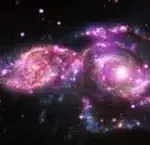 Naturalism suggests that our soul* is material. To accept this notion, not just as an abstract idea, but as a recognition in the depths of the soul, can provide a shock. How can this inner being – so weightless, so intangible – be made of the same thing as bricks and mortar, wood and water? But the evidence is clear – the anesthesiologist puts our soul to sleep with drugs, and a hard bump on the head also puts it to sleep. Were our soul un-material, it could defy these material things, but it can’t. Despite the ghost stories from all times and places, the soul resides in matter, its activities and insights are dictated by material conditions. The machine animates itself, no ghost is required.
Naturalism suggests that our soul* is material. To accept this notion, not just as an abstract idea, but as a recognition in the depths of the soul, can provide a shock. How can this inner being – so weightless, so intangible – be made of the same thing as bricks and mortar, wood and water? But the evidence is clear – the anesthesiologist puts our soul to sleep with drugs, and a hard bump on the head also puts it to sleep. Were our soul un-material, it could defy these material things, but it can’t. Despite the ghost stories from all times and places, the soul resides in matter, its activities and insights are dictated by material conditions. The machine animates itself, no ghost is required.
But then matter holds a few surprises, too. According to Einstein’s famous equation, E=MC2, matter is energy, and a little matter is a whole lot of energy. If one could, in an instant, convert all the matter of a brick into energy, it would shine with the brightness of a sun for a white hot instant. The light of that explosion would race off in all directions, traveling simultaneously as wave and particle, at the speed of light, which is the speed of time. Many other examples of the strangeness of matter could be provided. (I use “matter” in this piece as a shorthand for matter/energy.)
To reject the dualism of mind and matter, changes nothing about the reality of mind or matter, only our interpretation of it. If in the dualistic stance we considered the soul sacred or divine, should we not consider this “mere matter” sacred or divine after we reject dualism? After all, unaided this mere matter has evolved into soulful beings like our selves.
At this point, an astute reader might argue that matter has not evolved unaided; it has been aided, indeed forced, to evolve due to the laws of Nature. Yes, but what are these “laws” and where do they reside? The use of the word “law” to describe the regularities of Nature probably arose because many early scientists were Christians and they thought the laws resided in the mind of God, much like the moral law that God supposedly gave to Moses.
The modern view, however, is that the regularities of Nature simply arise as a consequence of the fundamental parameters of matter – the relative masses of the various particles and the relative strengths of the various forces. The so-called laws of Nature do not reside outside of matter, but within it. Or perhaps more correctly within the intricate interrelationships among the various particles and forces. (Why the universe has these unique parameters that lead to a self-organizing universe is simply a mystery, but if it didn’t, we wouldn’t be here to notice.)
The philosopher Heraclitus wrote: “You could not discover the limits of the soul, even if you wander over every path, so deep is its measure.” If this is true of the soul, then perhaps it is also true of matter.
Modern science has learned a great deal about matter, yet we are a long ways from fathoming its depths. To anyone who questions that statement, I will only say “dark matter, dark energy.” But dark matter and dark energy represent problems that will likely be solved, perhaps in the not too distant future. The problem of the ultimate origin of matter and of the parameters of various particles and forces, which I introduced parenthetically above, is a different kind of problem. Those parameters seem to be present at the earliest instant of our universe. We would have to get to a moment earlier than the earliest moment to find the information needed to solve this problem, and that might be impossible. Cosmologists have introduced the idea of a multiverse to describe what existed before the first moment of time in our universe. As it stands, however, a multiverse is more a metaphysical idea than an idea of empirical science.
So in its origin, matter remains unmeasured, remains a mystery. But this mystery is a part of matter, not something separate from it. It is, I think, part of the reason Nature is so interesting and so beautiful. As I wrote in an earlier piece published by SNS:
As ambiguity is to art, mystery is to Nature. For a few hundred years now, science has penetrated the layers of Nature’s mystery, but as each layer is penetrated a new layer is discovered. And this is not likely to end. Even if physicists should complete the quest for a final theory of physics, it has become increasingly clear that the theory will not answer the question of why and how the universe came to have the properties described by that theory. Like the Mona Lisa’s smile, Nature’s mystery refuses final resolution.**
The philosopher Plato suggested that the soul is some non-material entity that has become trapped in matter (heaven knows why). It is a grand idea and I understand why humans have embraced it. It says we humans are something special. But I don’t think so. It is this soulfully material world that is special; to the extent that we are special, it is not because we are apart from the world, but because we are a part of it.
* The word “soul” as I use it here refers to that which we can only experience inwardly and directly, never as an object. It is a delightfully unscientific term, yet I don’t think that there is any better.
** from Beauty in the Equation, published Feb. 21, 2013.
Learn about Membership in the Spiritual Naturalist Society
__________
The Spiritual Naturalist Society works to spread awareness of spiritual naturalism as a way of life, develop its thought and practice, and help bring together like-minded practitioners in fellowship.













